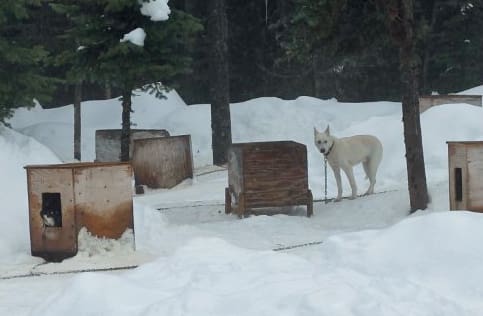Sign the pledge not to take part in sled dog tours
Sled dogs are tethered for long periods and it is still legal to shoot surplus dogs
Speak out for sled dogs

Who can forget it? The 2010 killing of 56 sled dogs in Whistler shocked B.C. and made headlines around the world. The public outcry prompted government intervention but has life really changed for sled dogs?
Many questioned whether justice was served when the sled dog tour company employee who killed the dogs was sentenced to three years’ probation, a $1,500 fine, 200 hours of community service, and a ten year firearms ban. It was alleged he had been instructed by the company to “cull” the dogs due to a downturn in business following the 2010 Winter Olympics.
Nevertheless, there was hope that public outrage would lead to positive change. The “Whistler sled dog massacre,” as it came to be known, shone a light on the sled dog tour industry and its treatment of the dogs. The provincial government responded with a code of practice and standards of care for the industry. But the effectiveness of these actions has long been questioned.
In a sad irony, it is still legal for tour companies in B.C. to shoot surplus sled dogs, provided the operator has “made reasonable efforts to rehome the sled dog, but those efforts have been unsuccessful” and the operator follows certain guidelines (as illustrated below).

A major problem with the provincial government’s regulation of care standards for sled dogs is lack of enforcement. This became clear when the regulation was introduced and no government funding was allocated to the BC SPCA to enforce the regulations. Tour operations are not inspected and action can only be taken if a complaint is made to the BC SPCA. In short, no one is watching to ensure regulations are followed.
Although the sled dog standards of care were a step forward, they did not ban tethering or chaining of dogs, which VHS and many animal advocates had called for. The standards only require that: “An operator must ensure that each sled dog is released from its containment area at least once in each 24-hour period, for the purposes of socialization and exercise.” This means a dog could be tethered for 23 out of 24 hours with violating the regulations.
Tethering is a contentious subject, with sled dog tour industry claiming it is humane while many animal advocates call for it to be banned. The 2016 documentary Sled Dogs, which revealed how tethering is the norm in the industry, quoted animal behaviour and animal welfare scientist Dr. Rebecca Ledger: “When they’re tethered they may live in community with other dogs, but that’s not a community – it’s a prison.”
The Canadian Veterinary Medical Association’s Code of Practice for Canadian Kennel Operations states that “Tethering of dogs (i.e., chains or ropes used to tie the dog to an immoveable object such as a stake or building) is not allowable as a method of confining a dog to a primary enclosure, nor as the only means of containment.” If true for a dog kennel, why not for a sled dog kennel?
